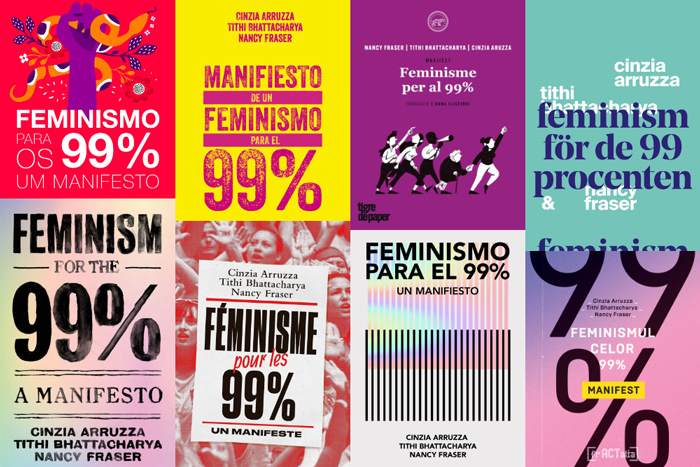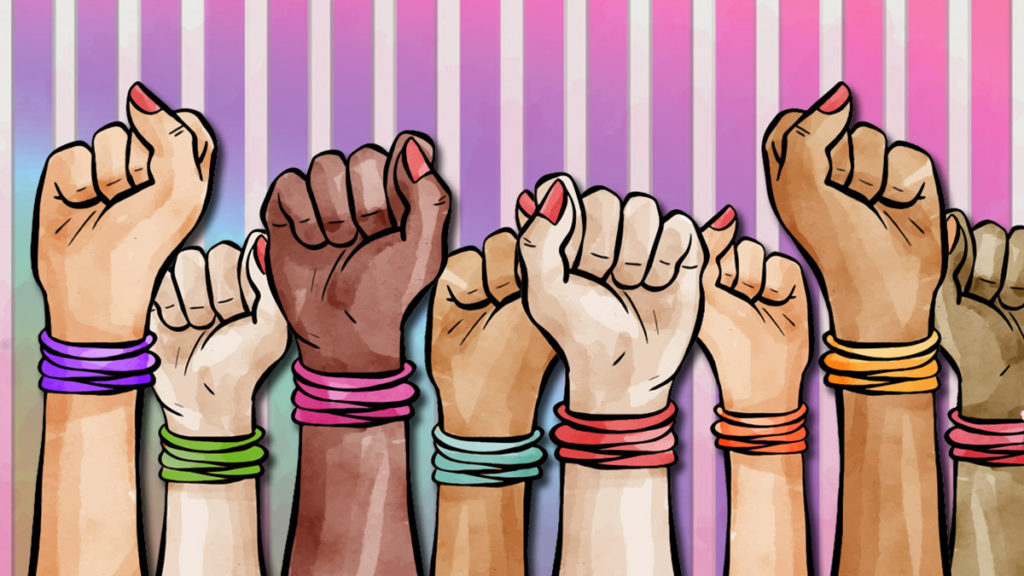The place where the manifesto “Feminism for the 99%” was written is no coincidence: In 2017, the United States was one of the epicenters of the resurgence of the feminist movement, with the Women’s March that brought millions of people onto the streets to reject President Trump on his first day in office. [2] It is also no coincidence that this manifesto appeared at a time when debates about feminist perspectives and strategy had been multiplying—as the authors point out, the movement is at a “crossroads.”
The publication of this manifesto by Cinzia Arruzza, Tithi Bhattacharya and Nancy Fraser comes at a time when the hegemony of liberal feminism is being called into question. Liberal feminism has monopolized the discourse about gender equality for decades, without questioning the exploitation of wage labor or the multiple forms of oppression that define the existence of most women.

The manifesto reflects many telltale signs of our epoch, marked as it is by the revitalization of feminism and the women’s movement. Global protests by women function, in turn, as a channel for expressing the growing social discontent experienced in capitalist society.
From our point of view, the root of this discontent—particularly among women—goes back to a contradiction. Certain sectors have attained a relative degree of equality before the law, and this generates hopes among the broad masses. But this contrasts with the persistent inequality in daily life, which is getting worse and combining with a multitude condemned to new “illegalities.” This is particularly difficult for the generation that grew up in the great metropolises where rights were slowly expanding and there were policies supposedly aimed at achieving gender equality and respect for diversity.
This is a contradiction that was incubated during the decades of neoliberalism, but it was only brought to light by the new economic crisis that began in 2008—which was not as severe as the crash of 1929, but has been going on for more than a decade—as elements of social crisis developed, alongside the growing illegitimacy of the political regimes themselves. This situation pushed the new wave of feminism forward, expressing a discontent that goes beyond what the current demands reveal.
Almost All of Us Oppose Neoliberalism, but Who Are the Anti-Capitalists?
This organic crisis has called the hegemony of neoliberal ideology into question, revealing that a tiny minority is living in the most obscene wealth by pushing ever-larger numbers of human beings into misery. In 2011, the 15-M movement in the Spanish State (with its slogan “we are not commodities in the hands of politicians and bankers”) and then the Occupy Wall Street movement (which said “we are the 99%, you are the 1%”) were the first political expressions of a generation that had to confront the fact that it would be worse off than its parents.
Since 2015, massive women’s mobilizations have taken place, and in this framework an increasingly active minority has begun to recognize that gender inequality cannot be analyzed separately from the global inequality created by capitalism. This idea is gaining in popularity, but it still doesn’t have an unambiguous definition. More often than not, most forms of feminism that consider themselves “anti-capitalist” only target the worst aspects of neoliberal policies without proposing to get rid of the entire system. What is becoming clear, however, is the inability of neoliberal feminism to respond to the problems and demands of the majority of women. Even more so, neoliberal feminism is complicit in legitimizing the system by propagating the idea that it is enough to place women in positions of power inside capitalist democracies, that is, including them in the management of exploitation. [3]
From this starting point, the manifesto says that an “anticapitalist feminism has become thinkable today, in part because the credibility of political elites is collapsing worldwide.” The authors propose challenging the feminism embodied by Hillary Clinton from the left: “In the vacuum produced by liberalism’s decline, we have a chance to build another feminism” (emphasis ours, since we will return to this word later). They attempt to “mark out the road that must be traveled to reach a just society,” explaining “why our movement must become a feminism for the 99%.”
Agreements, Disagreements and What Goes Unnamed
We agree with the definitions that the manifesto presents, in different chapters in the form of theses, about the capitalist crisis; about the roots of gender violence, including a critique of punitive solutions; and about the normalization and regulation of sexuality under capitalism, and the need to liberate it. We agree with the denunciation of the racist and colonial violence that marked the origins of capitalism. Capitalism is leading to the destruction of the planet, and the manifesto calls for an anti-imperialist, eco-socialist and internationalist feminism.
The manifesto’s international reception is significant for those of us who have been building an anti-capitalist, socialist and revolutionary feminist tendency for decades. This work was in constant opposition to the hegemony of liberal, technocratic feminism, which redefined the struggle for emancipation as an evolutionary path toward legal equality—in other words, as the search for the expansion of rights within capitalist democracies, which would permit meritocratic (individual) progress for a few women. As a minority, we had to challenge the powerless answers of post-feminism, which prioritizes “deconstruction” or “checking one’s privileges,” as if the structural and systematic oppression of certain groups could be fought, essentially, via an (individual) exercise in self-awareness.
It is encouraging that this new manifesto has resonated so strongly around the world, since it is centered on the idea that the oppression of women is structural within the capitalist system, and therefore can be ended only by a radical and collective transformation of society.
But how do we propose to set such a transformation in motion? To accomplish radical changes, the manifesto proposes: “Feminism for the 99% aims to unite existing and future movements into a broad-based global insurgency.”
That is all. The text does not say anything else on the subject. This leads us to think that the authors have unlimited faith in the power of social movements—as if it were unnecessary to prepare for a confrontation with the capitalist state (which is not mentioned in the manifesto), a state that not only has a monopoly on violence but also has many mechanisms for co-opting and assimilating oppositional movements. This is not a minor question: While some conceptualize social changes as the result of administering state resources or parliamentary work (i.e., reforms), others idealize the social question and disdain political struggle. Unfortunately, whenever radical and transformational social movements rejected struggle in the political arena, they allowed reactionary and reformist sectors to monopolize this space.
What preparatory tasks does feminism for the 99% need to complete in order to fulfill its goals? The authors answer in Thesis 11: “We must ally, above all, with left-wing, anticapitalist currents of those movements that also champion the 99%. This path pits us squarely against both of the principal political options that capital now offers. We reject not only reactionary populism but also progressive neoliberalism” (bold emphasis is ours).
Unlike the authors, we do not believe that a vacuum can exist in politics, as they claim in the first few pages. Reactionary populism is not the only alternative to the crisis of neoliberal hegemony—there are other political options that also form part of capitalist democracies and that, strangely, go unmentioned in the manifesto. We are referring to left-wing populist or neo-reformist parties such as Syriza in Greece (which, once in power, implemented the austerity plans of the troika and the European Union against the Greek people) or Podemos in the Spanish State (which transformed itself from the hope of the “indignados” into a part of the 1978 regime, and is currently begging the social democratic PSOE to form a coalition government).
These are not isolated examples. In opposition to the populism of the Trumpist right and the reemergence of “progressive” neoliberalism, a third option is being tested, which presents itself (in different variants) as “lesser-evilism” or left-wing populism in almost all latitudes.
The authors of the manifesto ask in Thesis 4: “Will profit-makers manage to turn capitalism’s social contradictions into new opportunities for accumulating private wealth? Will they co-opt important strands of feminist rebellion, even as they reorganize gender hierarchy? Or will a mass uprising against capital finally be ‘the act by which the human race travelling in the [runaway] train applies the emergency brake’?” (The quote is from Walter Benjamin.)
The answers to these questions cannot be determined in advance, since they depend not on the simple development of events, but rather on the struggle of living forces—the struggle of movements, the class struggle, but also the political struggle we carry out today to unmask all those who present themselves as a “lesser evil” and the friendliest face of the capitalist democracies in the context of the delegitimization of all their traditional representatives. That is why it is the task of the hour for revolutionaries to warn that the ruling classes are preparing to “co-opt important strands of feminist rebellion” in order to prevent a genuine rebellion from taking place, much less a “mass uprising against capital.”
Although the manifesto does not make any explicit statements about this political sector, two of its authors have declared publicly that they—with more or less enthusiasm—intend to vote for Bernie Sanders, who, with a discourse of wealth redistribution and “socialism,” is running in the primaries of the bloodthirsty Democratic Party. As if the character of U.S. imperialism could be changed “from within,” when in fact it is exactly the opposite: The system has displayed its ability to integrate even the most charismatic leaders, thus assimilating the movements that they represented.
In addition, as the authors of the manifesto know well, the “99%” that left populism wants to capture from the right on the electoral plane is not a homogenous “people,” but rather an abstract construct that includes mid-level owners of capital and those who have been historically expropriated by small, medium and big capitalists; it includes elite managers whose incomes are high enough to permit them to accumulate property and have a very high level of consumption, while they exploit the poorly paid labor of undocumented nannies, chauffeurs and cooks.

The petty bourgeoisie and the semi-colonial bourgeoisies are often junior partners of the large concentrations of finance capital. Although they are also sometimes victims of this same capital, they nonetheless live off the exploitation of others’ labor. Their interests therefore cannot be reconciled with those of working women around a political perspective against the “1%.”
Unlike in mathematics, an addition in politics can sometimes result in subtraction. This can be seen not only in Sanders’ campaign but also in Argentina, where, under the auspices of the Vatican, a large part of the progressive, center-left and center-right opposition has united in a “Front for All” against President Macri’s right-wing government. In both cases, as in many other countries, this is an attempt to subordinate the feminist movement to petty bourgeois or bourgeois political parties (including even imperialist parties or religious ones!), parties that will strive to maintain the capitalist system, against and despite the interests of women. [4]
We believe, in contrast, that the immediate task of anti-capitalist feminism is to clearly differentiate our allies from our enemies.
The Women’s Strike: A Bridge Between Identity Politics and Class Politics?
The metaphor of the “99%” is based on the atomization and fragmentation of the exploited classes and the oppressed sectors during the decades of the neoliberal offensive. It is, however, also important to mention that the capitalist restoration not only changed the physiognomy of the class of wage earners, but also vastly expanded wage labor across the globe.
For the first time in the history of capitalism, women constitute about 47% of this enormous class, but they are still primarily responsible for the unpaid reproductive labor performed in individual households. Yet the truly new and challenging fact is that today, 1.3 billion women (54% of women in the economically active population) participate in the labor market, [5] drastically changing the image of a “white, male working class” that only survives in the nostalgia of the treacherous union bureaucracies.
We believe that these changes in the composition of the class that represents a majority of society (at least socially, if not in absolute numbers) are expressed by the feminist movement’s adoption of the term “strike,” the workers’ traditional method of struggle. Even though most feminist organizations do not use it, [6] the strike slogan is a tool for feminism—a multi-class and still mostly urban movement, in which enlightened sectors of the petty bourgeoisie exercise political and ideological hegemony—to enter into a new dialogue with ever-larger sectors of working women.
It is also a weapon for women to challenge the bureaucratized leaderships of the unions, demanding that leaders offer concrete support for the demands of an increasingly large part of their rank and file. Often women workers have to mobilize outside the unions to make their demands heard, and sometimes do not even have the right to participate in these organizations.
In our opinion, the “reinvention of the strike” mentioned in the manifesto does not mean that all feminist actions, whatever they may be, can be called strikes. Nor does it mean calling for a withdrawal of labor while “broadening the very idea of what counts as ‘labor,’” where the authors confusingly mix the withdrawal of housework with that of “sex and smiles.” As Lorna Finlayson points out regarding the limitations of this type of strike,
The withdrawal of paid labour hits the capitalist in the form of permanently lost profits. The withdrawal of unpaid reproductive labour is less straightforward. If the labour takes the form of care for vulnerable others such as children or elderly relatives, withdrawal may not be an acceptable option. In the case of labour that isn’t a matter of life and death—washing up or vacuuming—the woman will either do it later, or someone else will. Or no one will, and the house will get slightly messier. At best, a husband or boyfriend might be shamed into doing something the woman normally does. The capitalist doesn’t suffer, or even notice.
On the contrary, the new interest in strikes should be put at the service of supporting women wage earners in their confrontations with their employers, the state and the union bureaucracy—especially when, as the manifesto describes, they are not only “focusing … on wages and hours” but also “targeting sexual harassment and assault, barriers to reproductive justice, and curbs on the right to strike.”
The current task of anti-capitalist feminism should be to fight inside the unions, especially in sectors where women are concentrated (including production and services), in order to unite what the bureaucracy divides. But the manifesto, which speaks of the working class, strikes, anti-capitalism and the class struggle, does not mention the union bureaucracy. Dangerously, it equates unions in general with the sectoral, economistic and corrosive policies of their leaderships.
It is also a preparatory task to take back the organizations of the working class from the hands of their bureaucracies, in order to turn them into truly democratic organizations of the entire class—organizations that do not reinforce but instead combat the divisions between native and immigrant workers, between people of different genders, and between directly employed and subcontracted workers, whether or not they have a legal right to unionize. From this perspective, these institutions with a long history in the workers’ movement could make strikes much more effective, rebuilding a bridge between the working class and the feminist movement, which has effectively been broken for more than a century. But while the manifesto proposes to use certain tools in this sense, it is based on the negation of a strategy that would make this possible.
For an Anti-Capitalist, Revolutionary and Socialist Strategy Based on Class Struggle
Although it is dealt with more thoroughly in the epilogue, the first thesis makes it clear that this manifesto was written with the conceptual framework of social reproduction theory. The authors point out that the assertion that capitalism is based on the extraction of surplus value is incomplete, that there is a “a truth that capitalism conspires to obscure: The waged work of profit-making could not exist without the (mostly) unwaged work of people-making. Thus, the capitalist institution of wage labor conceals something more than surplus value. It also conceals its birthmarks—the labor of social reproduction that is its condition of possibility.”
For the authors, the ongoing capitalist crisis is, fundamentally, a crisis of social reproduction, and this concept includes not only the unpaid domestic labor that we have already mentioned, but also service sectors that guarantee social reproduction via the exploitation of wage labor, mostly by women (health, education, etc.). A third aspect of this crisis of social reproduction concerns how imperialism permits women with better salaries in liberal professions in the metropolis to “liberate” themselves from domestic work by (precariously) employing women who are migrants, racialized, etc. These women, in turn, have to delegate the reproductive work in their own households, leaving girls or old women to take care of their siblings or grandchildren, to clean and cook without any kind of remuneration—they are in the most vulnerable position in this chain.
Without subscribing to any economistic or class reductionist (trade unionistic) version of Marxism, we must object to this postulate. We agree with the authors that the working class is not limited to those who work “in factories or mines.” The working class includes all those who work “in the fields and in private homes; in offices, hotels, and restaurants; in hospitals, nurseries, and schools; in the public sector and in civil society—the precariat, the unemployed, and those who receive no pay in return for their work.”
But while we do not have big differences about this sociological description of the working class, we do disagree about the political definitions that are derived from it.
We disagree in the first place because the authors’ theoretical conception leads them to assert that all sectors of the working class are “equally central” to confronting the capitalist system. From this, they conclude that “class struggle includes struggles over social reproduction,” citing struggles for housing, public transport and free education, among others. Moreover, they maintain that these struggles “now form the leading edge of projects with the potential to alter society, root and branch.”
In contradistinction to this, we observe that when the working class participates in these movements, it is diluted into a “mass of citizens”—because union leaders refuse to merge the just demands of broad sectors with an anti-capitalist struggle. To this end, the union bureaucrats collude with the political leaderships of other classes and sectors that also participate in social movements, trying to channel their demands via the political parties of the regime in order to avoid any radicalization.
The authors of the manifesto, in Thesis 11, say about industrial wage labor: “To insist on its primacy is not to foster, but rather to weaken, class solidarity.”
Giving a mortal blow to capitalism requires the social power of those sectors that keep the main wheels of production (and services) turning. These are the ones who make the realization of capitalist profits possible. Of course this also requires that these sectors (in which women participate at a much higher rate than just a few decades ago) establish an alliance with all other sectors that are oppressed by capitalism.
For this reason, we believe that any feminism that claims to be anti-capitalist needs to fight the sectoral, bureaucratic leaderships of the workers’ movement that maintain an arbitrary separation between the economic demands of wage earners and the democratic demands of the broader masses—this separation is beneficial to capitalism. But it also means fighting the (equally bureaucratic and sectoral) leaderships of the social movements that, denying the social power of the concentrated sectors of the working class in the struggle against capitalism, try to subjugate these democratic struggles to a limited reformist perspective, which in the context of the crisis is becoming increasingly utopian.
In other words, anti-capitalist feminism is a feminism of and for the working class, that is, of and for the social subject that capitalism places in a strategic position for its functioning (and from which that class can form alliances). Otherwise, anti-capitalist feminism will end up dissolving in a movement that is powerless to transcend the horizon of reforms. Of course, to realize the objectively revolutionary potential of the most concentrated sectors of the working class, they must achieve an effective and conscious will to lead all sectors (even of other classes) that are also oppressed by capital.
Achieving this is also a preparatory task. Unlike the 1970s, when there emerged a new feminist wave that was part of global processes of social and political radicalization, today a reformist perspective is still dominant. But we are not pessimistic, because new phenomena of class struggle and political phenomena of an international character (including this new feminist wave) can be the prelude to a new stage.
If anti-capitalist feminism aspires to be more than a spectator of events, if it aspires to intervene decisively in reality in order to transform it, then today it has the task of waging a political and ideological battle so that a large part of the women’s movement adopts this revolutionary perspective, preparing itself for future events.
Marxism with a strategic focus—opposed theoretically and politically to the economistic tendencies that have transformed it into a brutal totalitarian caricature—is faced with the challenge of not only elaborating eloquent analyses of patriarchal capitalism, such as those published in the manifesto, but also advancing strategic hypotheses and building an organization. This is necessary so that oppressed and exploited women, together with all the oppressed and exploited, can move forward—when circumstances permit it—from strenuous and patient resistance to the conquest of victory.
Notes
[1] We are grateful to comrades from our international tendency who provided critical feedback that was fundamental to the preparation of this article.
[2] The growing visibility of male violence—femicides, sexual abuse, impunity for the accused, victim blaming—was the driving force behind most of the mass women’s protests in other countries such as Argentina (Ni Una Menos, 2015), Italy (Non una di meno, 2016) and the Spanish State (Yo sí te creo, 2018); but also campaigns on social networks in the United States (#MeToo, 2017) or in France (#BalanceTonPorc, 2017). At the same time, other mobilizations arose to block restrictions to the right to abortion (Poland, 2016), to denounce the wage gap (Iceland, 2018) and to demand legal abortion (Argentina, 2018), causing multitudinous women’s actions.
[3] For an analysis of the feminist movement in the decades of neoliberalism, see Andrea D’Atri and Laura Liff, “Women’s Emancipation in Times of Global Crisis,” Left Voice, August 15, 2016.
[4] We mention the example of Argentina because it is one of the places where the women’s mobilizations were largest in recent years (Ni una menos, the Green Wave). For that reason it is cited by the authors of the manifesto as an inspiring example.
[5] Labor force participation rate, female (percentage of the female population aged 15-64), according to an ILO estimate.
[6] Except in the Spanish State, where the feminist strike of March 8 won the support of a large part of the unions.
Translation: Nathaniel Flakin
First published July 28 in Ideas de Izquierda.
* Note: A previous version of this article stated that the authors were New York intellectuals. It was not meant pejoratively and has been changed to reflect the writers’ activism.












